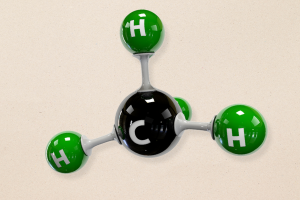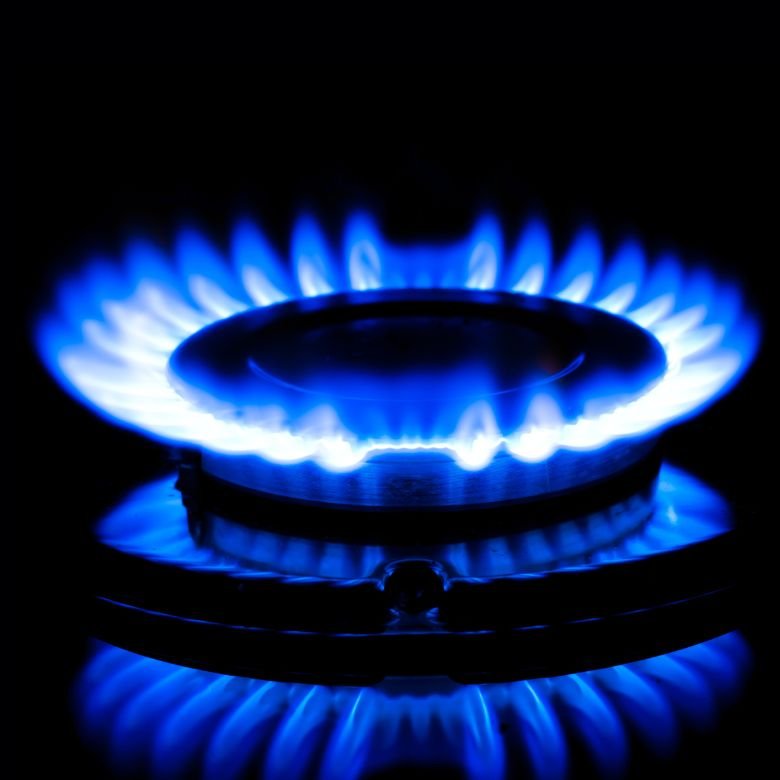Methane is one of the most essential chemical compounds on Earth. It is believed to have been discovered in the 1770s. It is an example of a simple organic compound with one carbon atom, which begins the homologous series of alkanes. There are many different ‘faces’ of methane. On the one hand, it is a valuable fossil fuel and a source of energy, and on the other – it causes 28 times greater greenhouse effect than carbon dioxide. Methane is also one of the most common causes of mine fires and mining disasters worldwide. Although its chemical structure is very simple, it has a wide variety of properties and applications.

Methane: general characteristics
Methane is the simplest compound in the homologous series of aliphatic hydrocarbons. The molecular formula of methane is CH4. Its molecule is made up of one atom of carbon and four atoms of hydrogen. All bonds between atoms in the methane molecule are covalent (sigma bonds). They have been shown experimentally to have the same length and energy. The angles between bonds are equal at 109°28′. The molecule of methane takes the shape of a regular tetrahedron. Accordingly, the carbon atom adopts sp3 hybridisation.
Preparation and properties
Methane is quite common in nature, with natural gas being its main source. Deposits of this fossil fuel are most often found deep underground or at the bottom of seas and oceans, from where it is extracted. The product obtained from such sources is often called organic gas, i.e. gas generated from the transformation of organic matter, under high temperature and pressure. Methane is also found in firedamp accompanying coalbeds, as well as in marsh gas released during the decomposition of plant residues. In the latter case, the gas is the product of a range of decay processes of organic substances. Significant amounts of methane are accumulated under the ocean sea-bed in the form of methane clathrates, where gaseous methane is trapped inside a kind of a ‘cage’ formed by water molecules.
In laboratory conditions, methane is obtained in a number of ways. One of them is direct synthesis from carbon and hydrogen at high temperature (500°C). Laboratories often use the reaction of aluminium carbide with water to produce methane molecules, as well as aluminium hydroxide. When you carry out the reaction, you should remember that methane is a gaseous substance, so if you want to collect the resulting product, you must prepare a special system to capture the gaseous products. Another laboratory-based method is to heat a mixture of sodium acetate and sodium hydroxide at an elevated temperature (decarboxylation).
The physical and chemical properties of methane:
- Odourless and colourless gas at room temperature.
- Highly flammable. It burns with a blue flame.
- Single methane molecules are very stable, however, its mixture with air or oxygen is explosive (methane content from 5% to about 14% by volume).
- The gas is resistant to chemical agents.
- Its density is lower than that of air.
- It is insoluble in water.
- Well soluble in organic solvents.
- It is non-toxic.
Methane undergoes a number of important chemical reactions. The most important ones include combustion reactions. With unrestricted air supply, complete combustion of methane occurs. The reaction results in carbon dioxide and water. This type of combustion is the safest and most efficient. When oxygen supply is limited, incomplete combustion of methane takes place. Depending on the amount of oxygen supplied, the products of such combustion include either poisonous carbon monoxide (II) and water or carbon and water.
Methane does not react with bromine and permanganic acid. This explains the lack of change in the colour of bromine water and potassium permanganate (VII) solution. However, it reacts with chlorine relatively easily. Alkane reactions with halogens are highly exothermic. The reactions between methane and chlorine are radical. Importantly, chlorination of this simplest alkane does not occur in the dark (it is usually initiated by light). In order for the reaction to happen, the entire system would have to be heated to a temperature of more than 250°C. Methane chlorination occurs when a chlorine molecule breaks down into two radicals, which then react with the other substrate and lead to the formation of methyl radicals and hydrogen chloride. The chlorination reaction does not stop at the monochlorination stage. The radicals that are formed interact with chlorine molecules or chlorine radicals. A molecule that does not undergo further chlorination is carbon tetrachloride where all hydrogen atoms are substituted by chlorine atoms. In fact, the end mixture contains all the said derivatives.

Key methane applications in the industry
One of the main applications of methane is its used as a source of energy. The energy is obtained by burning fuels containing this compound. Natural gas is an example of such fuel. Its methane content exceeds 90%. Once extracted, it goes almost directly to private consumers and the industrial sector. Methane combustion is also used in gas turbines to generate electricity and heat. It can also be used to heat homes.
Methane is used to propel motor vehicles. As a fuel, it is marketed under the name of CNG (compressed natural gas) or LNG (liquefied natural gas). Its combustion in cars is much more efficient compared to diesel or petrol.
Obviously, the chemical industry is a heavy user of methane. One chemical application is the production of hydrogen in a process called steam reforming. Therefore growing interest in hydrogen as the fuel of the future, entails growing interest in methane, too. Other chemical processes that use methane include the production of methanol, coal gas or plastics.
Methane is also indirectly involved in tyre production. The soot produced by incomplete combustion of the gas is one of the ingredients used to reinforce rubber used to make car tyres. The same soot can be used in the production of paints and printing inks.
Methane as a greenhouse gas
Among the gases and emissions that have the greatest impact on global warming, carbon dioxide comes first. It is a type of pollutant that persists in the atmosphere for a very long time, up to several thousand years. However, methane is even a more dangerous threat to the climate. As a pollutant, it is ‘only’ present for some 10 to 15 years, much shorter than carbon dioxide, but its impact on the greenhouse effect is much greater.

Methane clathrates
An interesting example of methane deposits that may potentially be a valuable source of the substance are so-called methane clathrates. Considering their chemical structure, you might often hear them being called methane hydrate, hydromethane or methane ice. Methane clathrates are a combination of water molecules and methane molecules. Water in this case forms a cage-like structure inside which methane is trapped. There are no chemical bonds between them. Clathrates are characterised by a crystalline structure and are formed under increased pressure. Physically, they look like white solids. They are odourless and resemble Styrofoam to the touch. Most commonly methane clathrates are found that are made up of 46 water molecules that surround two small and six medium-sized ‘cages’. Methane is trapped inside them.
Methane clathrates are still not a fully explored source of energy. It is because of the possibility of extracting significant amounts of methane from them for energy-generation purposes, they attract considerable interest. The resulting feedstock can be a very good alternative to conventional sources of hydrocarbons, however, insufficient knowledge about the extraction of methane from clathrates poses a great risk to the environment, which can be a consequence of uncontrolled release of methane into the atmosphere.
Biomethane
Biomethane is defined as a gas obtained from biogas. Biogas, on the other hand, is a gas obtained from biomass. It is formed through organic matter transformation, including plant and animal waste, landfills or wastewater treatment plants. Methane usually accounts for about 55% of biogas. Biogas is usually used directly, while its purification to pure biomethane is only undertaken in exceptional situations.
Biomethane comes in two states of matter: gaseous and liquid. It is formed during methane fermentation of biological waste. Virtually all of the biomethane thus obtained is aimed for energy-generation purposes. Many companies and manufacturing plants use biogas and the biomethane it contains to power the equipment that now often uses energy from natural gas. Even though it is a renewable source of energy, burning biomethane results in significant emissions of carbon dioxide, which is a greenhouse gas.
Read also: ethane, propane, butane.
- https://www.britannica.com/science/methane
- https://pubchem.ncbi.nlm.nih.gov/compound/Methane
- https://climate.nasa.gov/vital-signs/methane/?intent=121
- https://encyclopedia.airliquide.com/methane